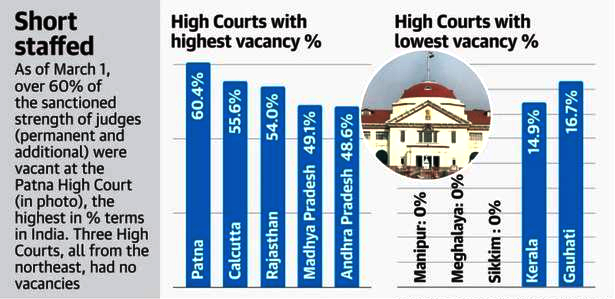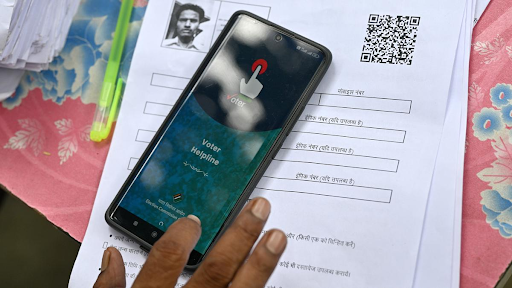Description

Copyright infringement not intended
In News
- To deal with the rising number of pendency, the Supreme Court of India has proposed "out-of-the-box" thinking, including roping in senior lawyers, to act as ad hoc judges in High Courts.
- The court highlighted that senior advocates in High Courts may not be willing to give up their lucrative legal practices permanently but may be interested in joining the Bench as ad hoc judges under Article 224A of the Indian Constitution for a limited period of 2 years.
Ad-hoc judges
- Unlike standard judges, which are selected through a normal procedure for a set period. Ad hoc judges are nominated by a unique process for a particular case, project, or period only.
- Under Article 127 of the Constitution of India, the Chief Justice of India can nominate a High Court judge as an ad hoc Supreme Court judge for a specified time when a quorum of permanent judges is needed to continue or hold a Supreme Court session.
- The Chief Justice can only execute this after consulting with the chief justice of the High Court and accepting the prior consent from the President of India.
- The Ad hoc judge carries all of the power, authority, advantages and obligations of a Supreme Court judge.
- Under Article 224A of the Indian Constitution, the Chief Justice of a High Court, with the previous consent of the President, may request any person who has held the office of judge of that court or any other High Court to sit and act as a judge of the High Court for that State.
- The Ad hoc judge carries all of the power, authority, advantages and obligations of a High Court judge.
- Supreme Court Guidelines for Appointment of an Ad-hoc Judge:
- The court orally outlined some guidelines for the appointment and functioning of an ad-hoc judge.
- The Chief Justice of India may appoint a certain [retired] judge if the pendency goes beyond a certain limit.
- Ad-hoc judges will be treated as the junior most.
- The retired judges would be chosen based on their expertise in a particular field of dispute.
.jpg)
Why ad-hoc judges?
- More than 70 thousand cases are pending in the Supreme Court according to the latest data available on the National Judicial Grid.
- Nearly 60 lakhs cases are pending in the High Courts.
- Over 40 million cases are pending in Subordinate Courts across the country.
- The high pendency of Cases in Some tribunals indicates that the objective of setting them is not achieved.
- According to data compiled from the National Judicial Data Grid, more than one lakh cases are pending in district and taluka courts for 30 years. Over 90% of these cases are pending in just 4 states: Uttar Pradesh, Maharashtra, West Bengal, and Bihar.

Why is there high pendency in courts?
- Lack of a sufficient number of judges and high vacancies in the judiciary and long leave to judges deteriorate the already grim situation.
- Frequent adjournment of the cases even on frivolous issues.
- India has very few courts compared to its huge population.
- Excessive litigation from the government side, the government is the largest litigant, responsible for nearly half the pending cases and most of them are on petty issues such as interdepartmental conflict.
- The lack of quality judges in the lower judiciary leads to appeals to the higher judiciary in most cases.
- Archaic laws or vague laws present another challenge as it takes time to interpret the law and most of the time matters go to higher courts through appeal.
- Poor police investigation leads to poor collection of evidence and hostile witness thus adjourning the hearing for the next date.
- Increasing the number of use of Public interest litigation (PIL).
- Increasing awareness among citizens about their rights and law courts.

Copyright infringement not intended
What are the consequences of the pendency of cases?
- Common people’s faith in the judiciary declines.
- It denies true justice to under-trial prisoners, many of whom get acquitted after spending many years which is a violation of their fundamental rights and also spoil their whole life.
- The economic cost of pendency is also very huge. Projects worth billions get delayed amid delays in judgement. It is estimated that delay in justice costs 1.5% of GDP annually which also deters future investment in India.
- Delay in justice also fails to create deterrence in the mind of criminals thus crime goes on perpetuating.
- Overcrowding of jails is also a result of a delay in judgment.
- The criminalization of politics keeps on rising as culprits are not punished timely.
.jpg)
Steps need to be taken
- National Litigation Policy should be revised.
- Address all 3 stages of dispute:
- Pre-litigation
- Litigation
- Post litigation stage.
- Establish Fair accountability mechanisms, Consequences for violation must be provided.
- Appointment of a Nodal Officer to regularly monitor the status of the cases in every department.
- Promotion of alternative dispute resolution mechanisms to encourage mediation.
- Coordinated action between government and judiciary.
- Judicial capacity should be strengthened in the lower courts to reduce the burden on higher courts.
- Increase expenditure on the judiciary.
- Improve court case management and court automation system.
- Create subject-specific benches.
- Tax departments must limit their appeals as their success rate is less than 30% at all three levels of the judiciary.
- Robust internal dispute resolution mechanisms
- Step-by-step online dispute resolution must be adopted as done by the Ministry of Consumer Affairs.
- Judges should write Shorter and more Pointed judgments.
Way Forward
- Courts need to monitor the progress of Cases based on urgency and type of Case.
- Courts must set a time limit to dispose of certain types of Cases.
- Understand why Some Courts perform well despite a Shortage of judges and adopt Such Courts as role models.
- Use of information and communication technology to improve the efficiency of the courts.
- Increase the number of judges and fill the vacancy as soon as possible.
- Increase the number of courts in India to tackle the huge population.
- Improving the police investigation and scientific way of collecting evidence.
- Reduce the leave of judges and increase the number of days of working in courts.
- Only genuine PIL must be entertained by Courts and courts must inflict heavy costs on frivolous PIL.
- Analytics tools can be developed in a manner that helps the judges monitor Cases based on parameters Such as how long an accused has been in judicial custody, Cases that Can affect the General public, and Cases that have been long pending.
- Alternative methods should be used for dealing with non-criminal offenders and petty criminals.
Must Read: https://www.iasgyan.in/daily-current-affairs/sc-judges-rules
https://epaper.thehindu.com/Home/ShareArticle?OrgId=GTKAK39GF.1&imageview=0
https://t.me/+hJqMV1O0se03Njk9






.jpg)









